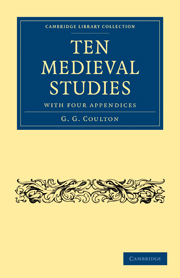Book contents
- Frontmatter
- PREFACE TO FIRST EDITION (1906)
- PREFACE TO SECOND EDITION (1915)
- PREFACE TO THIRD EDITION
- Contents
- I The Monastic Legend
- II A Revivalist of Six Centuries Ago
- III Side-Lights on the Franciscans
- IV The High Ancestry of Puritanism
- V Romanism and Morals
- VI The Truth about the Monasteries
- VII Religious Education before the Reformation
- VIII Priests and People before the Reformation
- IX The Failure of the Friars
- XIII The Plain Man's Religion in the Middle Ages
- Appendices
- Index
IV - The High Ancestry of Puritanism
Published online by Cambridge University Press: 07 September 2010
- Frontmatter
- PREFACE TO FIRST EDITION (1906)
- PREFACE TO SECOND EDITION (1915)
- PREFACE TO THIRD EDITION
- Contents
- I The Monastic Legend
- II A Revivalist of Six Centuries Ago
- III Side-Lights on the Franciscans
- IV The High Ancestry of Puritanism
- V Romanism and Morals
- VI The Truth about the Monasteries
- VII Religious Education before the Reformation
- VIII Priests and People before the Reformation
- IX The Failure of the Friars
- XIII The Plain Man's Religion in the Middle Ages
- Appendices
- Index
Summary
The more generally the history of medieval religion is studied, no longer by one party exclusively, but by men of widely different views and sympathies, the more evident it becomes that the lessons of Church history contain correctives for the one-sided tendencies of all religious denominations. Nothing, for instance, has more hopelessly undermined extreme ritualism than the historical researches of the most learned ritualists, who have discovered that the thirteenth-century altar was bare indeed, compared with many which seem quite moderate nowadays; and that (to quote from one of them) “Some pious usages [of later ritual] flow from very muddy sources”. We are here on the outskirts of a truth which only wider study will finally establish, but which is dawning more clearly every day, that the pre-Reformation Church resembled modern English religion, with all its cross-currents and tangle of authority and conflict of sects, far more nearly than either Romanists or “advanced” Anglicans care to realize. A man dissatisfied with the modern world, if suddenly set back into his imaginary paradise of the thirteenth century, would find himself still confronted by a great deal which he specially abhors in modern nonconformity; and it would, perhaps, grate on him all the more for being then labelled with the label of the Church. Even Baptists and ritualists are on better terms with each other nowadays than were the parish clergy and the friars of the Middle Ages: and the modern priest, who loses no opportunity of expressing his dislike for Puritanism, little suspects how much Puritanism there was in the highest places during the crowning period of the pre-Reformation Church.
- Type
- Chapter
- Information
- Ten Medieval Studieswith Four Appendices, pp. 58 - 71Publisher: Cambridge University PressPrint publication year: 2010First published in: 1930



